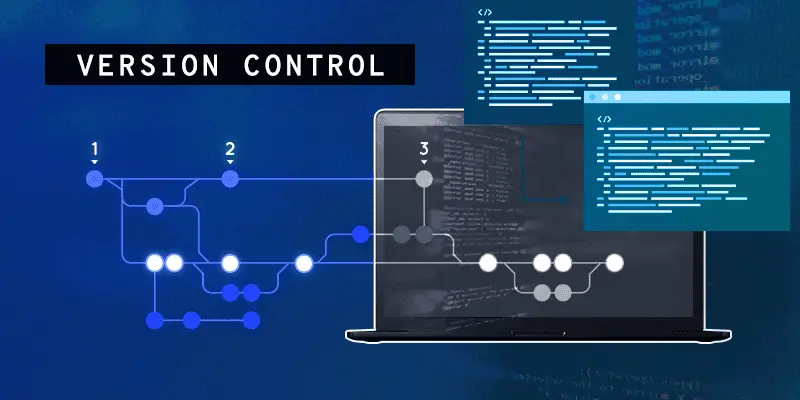The ability to quickly develop and release applications and updates in Salesforce is very important. This is more easily accomplished with a large development team. And for large corporations, this team can be spread throughout multiple locations.
But you don’t need a multinational development team to run into issues. Combining the efforts of a multi-developer team will introduce unique challenges.
Your team might find it difficult to collaborate on a singular project. Every developer working on their own lines of code is going to alter different aspects of the project. Keeping these alterations straight becomes more difficult over time.
And what happens if someone makes a mistake? It’s extremely difficult to trace bugs back to the source when they are committed to the project.
Version Control is an essential tool in source code management. It is the cornerstone of developmental organization and a critical component of a successful DevSecOps strategy.

Here are 8 version control benefits your development team can expect from utilizing a reliable system:
1. Risk-Free Collaboration
Multiple developers working on a singular project can run into issues. The most common of these issues would be for more than one person to be working on a particular aspect of the project, leading to code overwrites.
Version Control creates copies of each version of the code commit.
This allows a team of developers to revert to previous instances of the project should an overwrite occur. Nothing will be lost. Functionality can be quickly and easily resumed.
Incompatible code is another potentially harmful side effect of a multi-developer team. The ability to separate versions of code commits along with the shared repository makes it easy to find and correct bugs.
2. Maintains Stability of File Servers
Version Control maintains an updated—and shared—master repository of data for the project. This allows each team member to work on the project without the need to directly communicate with their team members.
The freedom to work through various sections of the project without worrying about interfering with other developers streamlines the process.
These updates and changes are stored throughout the various versions and can be quickly referenced should an issue arise. Team members that aren’t constantly worrying about the stability of the file itself are free to focus on the project.
Strong collaboration creates better—and stronger—releases.

3. Increases Accountability
Every project isn’t going be perfect. There will be mistakes. And the ability to track down the source of these mistakes makes it easier to fix bugs, as well as providing the opportunity to work toward fixing the problem that created the bug in the first place.
Version Control assigns time stamps as well as personal identifiers for every commit to the shared repository.
This allows a development team to compare updates, make any necessary changes, and merge an optimized version of the commit.
Mistakes can be easily found and rectified. It also provides an opportunity to teach the person responsible for introducing errors to the system, so they can be avoided in the future.
4. Keeps Project In-Sync
Every change to the shared repository needs to work together in harmony. Any failure to do this can lead to a failed deployment or improper functionality of the ultimate project.
Version Control allows developers to stay on the same page as they work through their individual code commits.
A well-organized development team will provide the most effective and timely results. Strong communication and collaboration reduce the chances of incongruous code updates. Accountability ensures nothing slips between the cracks.
5. Aids Deployment
Successful deployments rely on strong, reliable code. Utilizing Version Control along with other Application Lifecyle Management (ALM) tools creates stable, reliable applications and updates.
Version Control is an essential tool to work toward a successful Salesforce deployment.
Merging the efforts of multiple developers into a single code repository prepares the development project for a successful deployment. Coupling this with a static code analysis solution like CodeScan will find any potential vulnerabilities and ensure everything works properly when it comes time to deploy the project.
6. Regular Backups of Code
Data disasters are unfortunately common. Any disruption to your Salesforce system—whether through user error, a cybersecurity threat, or hardware failure—can cause you to lose data essential to your development project.
An inability to retain this information will create redundant work for your team, costing the company time and money.
Version Control copies multiple versions of the Salesforce development project which can be called upon should the shared repository become corrupted or compromised.
This is also useful if you notice that your development project isn’t working as well as it should. Any mistakes can be instantly undone by restoring an older version of the project.
7. Clear File Structure
Salesforce development projects can grow quite large. This creates a confusing structure that can be difficult to sort through for a multi-developer team.
A well-organized and easily navigable file structure makes it easier for team members to find information and data. It also streamlines the process of finding and fixing bugs.

Version Control allows each developer to work through their own version of the project before sharing it to the repository. Comments, issues, additions, and more can be easily traced and addressed.
8. Variety of Options
Version Control solutions are available from multiple suppliers, and all the top suppliers can be integrated into the AutoRABIT Automated Release Management system.
This includes:
- GIT
- Bitbucket
- Subversion (SVN)
- Team Foundation Server (TFS)
Your Salesforce instance is likely to have many unique qualities. Consider the evaluation process, use cases, purpose, and affordability when selecting the Version Control solution that works best for your company.
This powerful tool optimizes many important aspects of the Salesforce development process, as well as providing useful security measures that can keep your team on track.
